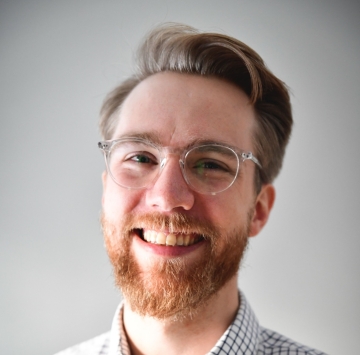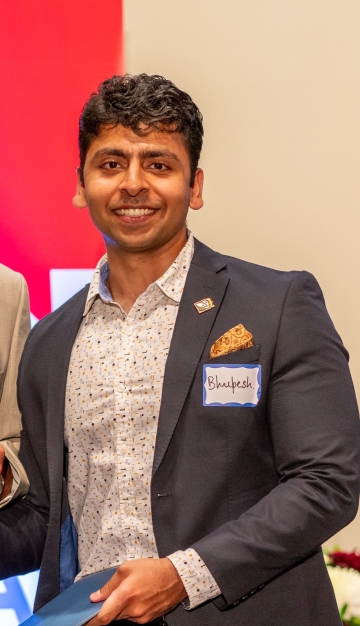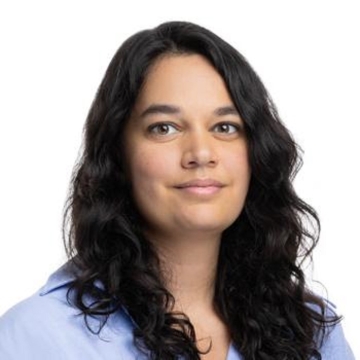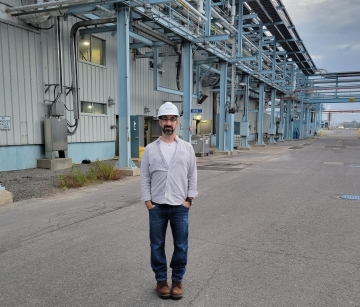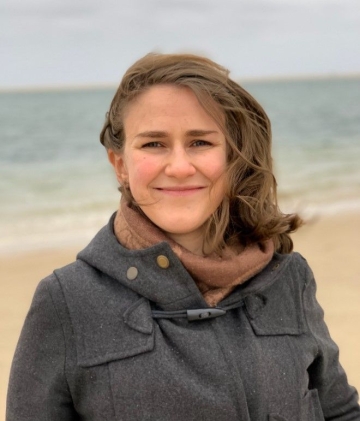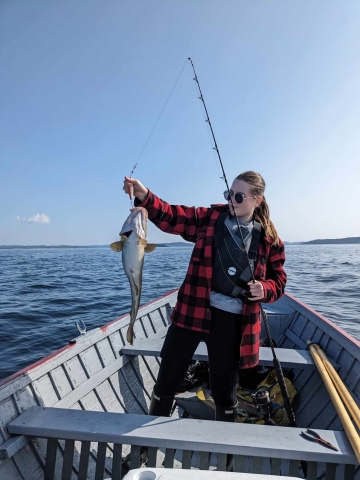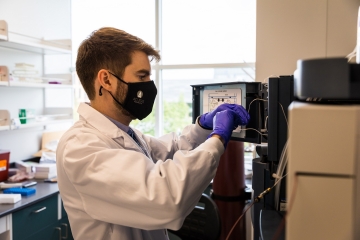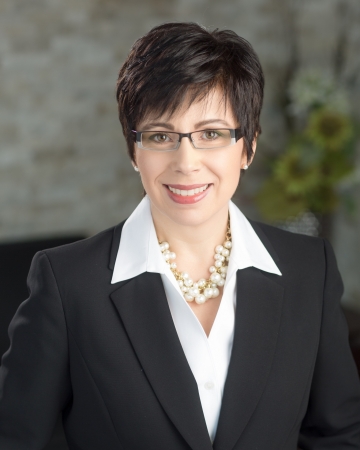Wiebke Jansen
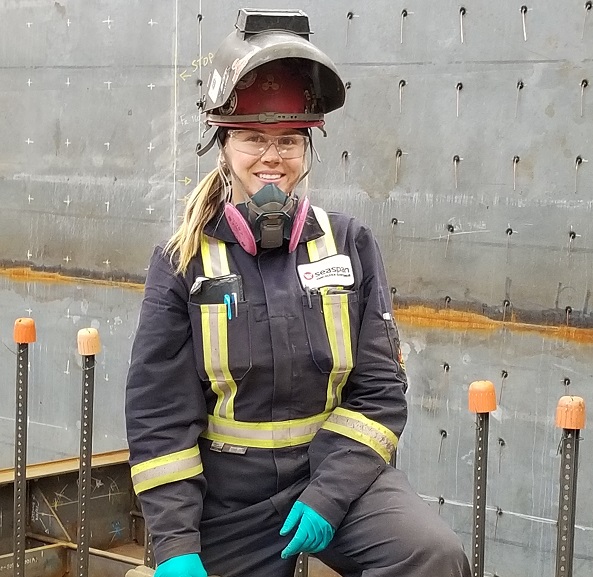

About me
I was born/grew up in: Schwalmtal, West Germany.
I now live in: North Vancouver, BC.
I completed my training/education at: I went to high school and graduated in economics and administration from a college in Germany before moving to Canada. As part of my apprenticeship in welding program, I attended the British Columbia Institute of Technology (ITCB) for each year of apprenticeship, which is four years
What I do at work
As an apprentice welder at Seaspan Shipyards, I am part of a great team. Together, we are building great ships for the Canadian government.
Welding is a manufacturing process that fuses two parts together using heat, pressure, or both. The most commonly welded materials are metals, such as aluminum, mild steel (low carbon steel), and stainless steel.
In welding, the heat source is usually produced by an electric arc, which looks like a small lightning bolt. Electricity flowing through the air space between two metal electrodes creates an arc with a temperature of around 3600 degrees Celsius! In comparison, the sun has a temperature of around 5,500 degrees Celsius.
There are different welding processes. At Shipyards, we usually use electric wire welding. This type of welding is a process by which filler metal (the metal that is used to join two other parts together) passes through a welding gun, producing hot metal. As the wire passes through the welding gun, shielding gas also comes out of the welding nozzle. Shielding gas plays an important role in weld quality as it protects hot liquid metal from air during the welding process (as air can weaken the corrosion tolerance of the weld). As it cools, the two (or more) parts welded together will create a solid joint.
We have several large workshops at the shipyard. The smallest welded parts are produced in the first workshop. Then these parts are transferred to the next workshop where they are welded to larger parts on panels. These panels are then assembled into large blocks. They are then transported to the last station. This is where all the crafted blocks come together to form a ship.
It's exciting to watch the evolution of parts, and to see parts that you welded that started out as smaller, turn into huge blocks. It's a bit like Lego blocks, but for adults;)
During the working day, safety is the most important aspect. I must wear my proper personal protective equipment (PPE) all day. My PPE includes fire-resistant coveralls, hard hat, steel-toed boots, safety glasses and hearing protection. I also wear other PPE depending on the tasks I am performing. When I weld I must also wear a dark tinted welding helmet to protect my face from ultraviolet rays. It also helps me see the molten metal under the electric arc. I also wear a respirator to protect myself from potentially harmful fumes.
At the end of the day, I inspect all the work I have done. I am proud of everything I have welded. It is very rewarding to be able to see what you have accomplished during the day.
My career path is
Considering the fact that I have a degree in economics and administration, I would say that a few years ago, I never thought I would end up working in a trade! In my last year of school, the idea of a full-time office job bored me a bit. I moved from Germany to Whistler for a year. Luckily, I got a job as a construction laborer!
After a while, I became a welder's helper for this same construction company. Before I got this job, I had no idea what welding was like. I befriended the welder, and as soon as we had a bit of time he would explain to me what welding was and even let me do a few welds! I immediately fell in love with the job, and had a lot of fun. When I became a permanent resident of Canada, I was able to register as an apprentice. I completed my Level 1 academic training in welding at ITCM in Vancouver. Then I was hired by Seaspan Shipyards, where I am still today.
I am motivated by
Every day on the job is fun at Seaspan Shipyards. It's a challenging job where I learn new things every day. Welding is practically a hobby for me.
As an apprentice at Seaspan Shipyards, I can see the progress I have made in the past year, and I am very proud of it. Some welds that I found difficult to do, like ceiling or vertical welds, are getting easier and easier day by day. Since I really enjoy working manually, I couldn't imagine sitting at a desk all day.
At work, I also met my best friends and girlfriends, and it's great to see them every day and collaborate on the same project!
I'm also delighted that there are a few women on the site who work in different trades. I am part of the change taking place in the skilled trades!
How I affect peoples’ lives
Doing quality work is the most important aspect. Welds must meet specific standards designed for the vessel under construction. They ensure that it can be used safely after production.
My work is important because it keeps people safe. Knowing that people will be crossing oceans on the ships we have built, and that we are responsible for their safety, illustrates the relevance of a career in welding. You can compare it to the reliability of a car. When driving on the highway, there is no fear of the bumper falling.
Outside of work I
I love the outdoors! Mountains, lakes and the ocean; this is where I am happiest! So I'm very happy to live in North Vancouver because this place allows me to do all of that!
In the winter, I am still skiing and snowboarding. In the summer, I like to go camping on the weekends, climb mountains and paddle board on lakes! In the summer I also play softball on a team with all my friends, it's a lot of fun!
My advice to others
Get out of your comfort zone! A few years ago, I never would have thought of a career as a welder in a shipyard. Now, I can't think of a more fun and enjoyable job. Don't be afraid of being in the minority in an industry; that's just one more reason to do it!
- Business & Economics
- Geography
- Physical Education/Health
- Brought People Together
- Always wanted to be outside
- Liked helping people
- Wanted to be in charge
- Felt at home in the outside, natural environment
- Wasn't sure what I wanted to do
- Learned Best by Doing
Related Topics
Partners
Let’s Talk Science appreciates the support of Seaspan Shipyards in connecting us with this individual.
Seaspan Shipyards is a leader in Canada’s shipbuilding and ship repair industry. With modern facilities and a dedicated workforce of 2,700 in North Vancouver and Victoria, Seaspan Shipyards has proven itself to be a trusted partner on a range of complex projects for both government and the private sector. Seaspan Shipyards is proud to be Canada’s chosen non-combat shipbuilder under the National Shipbuilding Strategy (NSS). In this capacity, the company is building state-of-the-art ships in Canada for the Canadian Coast Guard and Royal Canadian Navy. Through its NSS-related work, Seaspan Shipyards is creating jobs, generating economic benefits and rebuilding Canada’s shipbuilding and marine industries.

